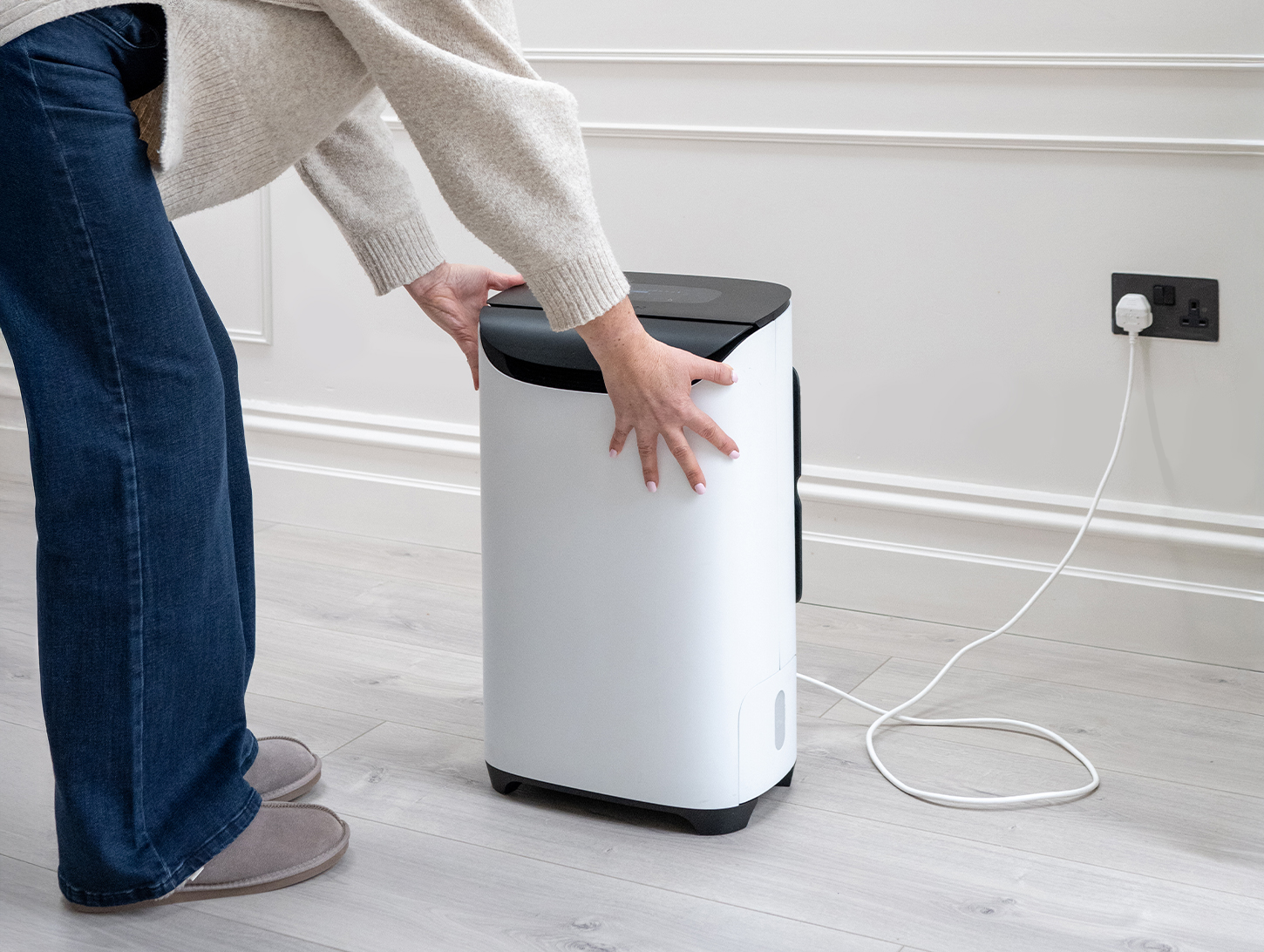
University life is full of excitement and new experiences, but for many students in the UK, adjusting to the realities of shared accommodation can bring unexpected challenges. One of the most common issues faced by students is dealing with excess moisture in their living spaces. This problem, often underestimated, can lead to more serious issues such as dampness, mould and musty smells, creating an unpleasant living environment. As students settle into their new homes, particularly in shared accommodations, managing moisture levels becomes essential, especially during the cold and wet autumn and winter months.
While opening windows is a common way to ventilate a room, it’s not often a practical solution. Cold weather, heavy rain, and security concerns in urban areas make it difficult to leave windows open for extended periods. So what’s the best way to tackle this problem? Chris Michael, air treatment expert and managing director of Meaco suggests that using a dehumidifier is a practical and effective way to combat moisture issues in university halls and shared houses.
Here’s why every student going away to university should consider investing in a dehumidifier.
1st Year University Accommodation: A Perfect Storm for Moisture Issues
First-year university students often find themselves living in shared accommodation with limited space and facilities. Whilst the accommodation itself is generally in good condition, the everyday activities of students living there can cause moisture issues. In many cases, due to a lack of communal space, no tumble dryer (or the high costs associated with it), drying laundry in their bedrooms is the only option available. This leads to a significant increase in indoor humidity, as damp clothes release moisture into the air. Without proper ventilation or a dehumidifier, this moisture can quickly lead to condensation and the growth of mould, which is not only unsightly but can also pose health risks in such close proximity to where the student sleeps.
For those living in bedrooms with ‘wet’ rooms or en-suite bathrooms, the situation can be even more problematic. These spaces often lack windows, relying solely on extractor fans to remove moisture. If there is no fan or if the fan isn’t functioning properly, moisture from showers and baths lingers, exacerbating the risk of dampness and mould growth. A dehumidifier positioned in the hallway can help by removing excess moisture from the bathroom.
Tip: Students can check if their extractor fan is working correctly by holding a piece of paper against it. If the paper sticks, the extractor fan is doing its job. If the paper falls, the extractor fan does not work, increasing the risk of damp and mould.
2nd and 3rd Year Housing: A Growing Problem
As students move into shared and privately rented houses in their second and third years, the issue of excess moisture doesn’t go away – it often gets worse. Many landlords are uninterested in maintaining their properties, leaving students to deal with condensation, mould, and dampness on their own. With four to six people living together, the amount of moisture in the air can quickly become problematic.
One of the biggest contributors to high moisture levels in student houses is drying laundry indoors.: With several people drying their clothes in the same room or their own rooms at the same time, the moisture levels skyrocket, leading to long drying times, musty-smelling clothes, and a damp overall indoor environment. Moreover, the wait to use clothes horses or radiators becomes longer, causing further frustration and inconvenience.
Damp air takes longer to warm up, so heating becomes less efficient the higher the moisture level in the property, leading to higher energy bills.
On top of this, shared student houses see a lot of individual cooking and frequent showers or baths, particularly in larger households. Each of these activities adds more moisture to the air, increasing the likelihood of condensation on walls and windows, and creating an ideal environment for mould growth and damage to the property.
What Causes Damp and Mould in Student Accommodation?
Many students may not fully understand why dampness and mould seem to be such a frequent issue in university accommodation. The reality is that a combination of factors makes student housing particularly susceptible. Older buildings, often used as student residences, are more likely to have outdated insulation and poor ventilation, making it harder for moisture to escape. As previously mentioned, high occupancy levels in small spaces also mean that moisture from activities like breathing, cooking, and showering builds up quickly. Additionally, budget constraints make students less likely to use tumble dryers, opting instead to dry clothes indoors, further exacerbating humidity levels.
The Health Risks of Damp and Mould
Damp and mould in student accommodation can do more than just make rooms smell unpleasant – it can also pose serious health risks. Prolonged exposure to mould spores can lead to respiratory issues, such as asthma and bronchitis, particularly for those with existing conditions. Mould spores are known to trigger allergies, leading to symptoms like sneezing, skin rashes, and eye irritation. Take a look at some further information from the NHS. For students already dealing with the stresses of academic life, living in such conditions could impact their overall well-being and academic performance.
The Solution: A Low Energy, Low Noise Dehumidifier
A dehumidifier can make a massive difference to students living in shared accommodation. By actively removing moisture from the air, it helps prevent the build-up of condensation, dampness, and mould. This not only protects the physical condition of the living space but also promotes a healthier living environment, reducing the risk of respiratory issues caused by mould spores, leading to a much healthier and comfortable environment to study and relax in.
For students, this means fewer worries about damp laundry as dehumidifiers often come with dedicated laundry modes that result in much quicker drying times. This is particularly important during the winter months, when drying clothes outside is not an option.
Choosing the Right Dehumidifier for Your Space
When selecting a dehumidifier, it’s important to choose the right model based on the size of the space you’re living in. Given that this appliance will be used frequently in the property, students should prioritise energy efficiency, low noise levels, and a laundry mode when selecting a dehumidifier.
Students may worry about the cost of increased energy bills, however with dehumidifiers costing from just 4p/kWh* to run, they can be assured that the benefits of running a dehumidifier outweigh the costs – especially because removing damp air from their house will actually help to reduce their heating bills!
- For single room use, such as a student bedroom or small studio, we recommend the 10L ABC or 10L Arete® One, which are perfect for smaller areas and provide efficient moisture control. The Arete models – Europe’s most-loved dehumidifier family – also have the added benefit of being designed to sit flush against the wall, making them an excellent choice for students with limited space.
- If you’re living in a 2-3 bedroom house and need to tackle moisture throughout the whole property, the 12L ABC or 12L Low Energy models are ideal for maintaining balanced humidity levels.
- For larger homes, such as a 4-5 bedroom house, you’ll need a more powerful option like the 20L Low Energy or 20L Arete One, both of which are designed to handle high moisture output across multiple rooms, ensuring effective moisture management for the entire house.
Benefits of a Dehumidifier for Landlords
Landlords can also benefit from providing their student tenants with a dehumidifier. Excess moisture doesn’t just pose health risks for tenants – it can cause long-term damage to the property itself. By investing in dehumidifiers, landlords can protect their properties from damp and mould, potentially saving thousands in costly repairs over time. Plus, offering dehumidifiers to tenants shows that the landlord is proactive about maintaining a safe and comfortable living environment, which can help with tenant satisfaction and retention.
The Long-Term Benefits of Using a Dehumidifier
Using a dehumidifier doesn’t just provide short-term relief from damp and condensation. Over time, it can also lead to significant cost savings. Mould and damp can cause long-term damage to furniture, clothing, and even the structure of the accommodation itself. By using a dehumidifier, students can protect their belongings and avoid costly replacements. Additionally, damp environments are notoriously difficult to heat, leading to higher energy bills. By keeping the air dry, dehumidifiers help rooms retain heat more effectively, making them easier and cheaper to keep warm. Dehumidifiers are also useful year-round, not just in the colder months. During warmer seasons, they can help control excess humidity caused by warmer weather, showers, or cooking, ensuring a comfortable living environment throughout the year.
Final Thoughts: A Must-Have for Every Student
Given the challenges faced by students in both university halls and shared houses, a dehumidifier is not a luxury item – it is a necessity. It ensures a healthier, more comfortable living environment by tackling the excess moisture that is so common in student accommodation.
As an alternative to costly tumble dryers, it saves as much as £1 to dry a load of wet washing whilst at the same time helping make heating more efficient. Leading to lower energy bills all year round.
For anyone looking to improve their living space and protect their health while in student accommodation, investing in a dehumidifier is a smart, practical choice.
Check out our most-asked questions about dehumidifiers.
*Running cost based on 26.35p / kWh while using a MeacoDry Arete® One 12L dehumidifier.
Featured:
- Energy efficient – running costs of 3p / hour
- Whisper quiet at just 35 dB
- Which? Best Buy and Quiet Mark accredited
- Shop Arete® online
- Energy efficient – just 3p / hour based on 22.36p / kWh
- Quiet Mark winner – our quietest dehumidifier at just 36dB
- Eliminates moisture – ideal for damp, mould and condensation
- Shop MeacoDry ABC online






